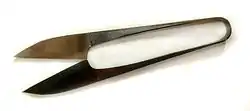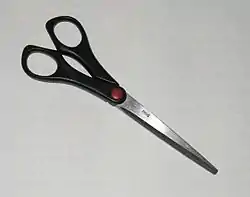鋏
| ||||||||
Translingual
Han character
鋏 (Kangxi radical 167, 金+7, 15 strokes, cangjie input 金大人人 (CKOO), four-corner 84138, composition ⿰釒夾)
References
- KangXi: page 1307, character 7
- Dai Kanwa Jiten: character 40450
- Dae Jaweon: page 1809, character 13
- Hanyu Da Zidian (first edition): volume 6, page 4205, character 7
- Unihan data for U+92CF
Chinese
| trad. | 鋏 | |
|---|---|---|
| simp. | 铗 | |
Glyph origin
| Old Chinese | |
|---|---|
| 瘞 | *qrebs |
| 瘱 | *qeːbs |
| 脥 | *kʰemʔ |
| 浹 | *skaːb, *skeːb |
| 挾 | *skaːb, *ɡeːb |
| 夾 | *kreːb |
| 郟 | *kreːb |
| 筴 | *sʰreːɡ, *kreːb, *keːb |
| 裌 | *kreːb |
| 鵊 | *kreːb |
| 狹 | *ɡreːb |
| 峽 | *ɡreːb |
| 硤 | *ɡreːb |
| 陜 | *ɡreːb |
| 陿 | *ɡreːb |
| 翜 | *sraːb, *srɯːb |
| 梜 | *kraːb, *keːb |
| 頰 | *keːb |
| 莢 | *keːb |
| 鋏 | *keːb |
| 蛺 | *keːb |
| 唊 | *keːb |
| 悏 | *kʰeːb |
| 匧 | *kʰeːb |
| 愜 | *kʰeːb |
| 篋 | *kʰeːb |
| 俠 | *ɡeːb |
| 綊 | *ɡeːb |
Pronunciation
Definitions
鋏
Japanese
Readings
Etymology 1


| Kanji in this term |
|---|
| 鋏 |
| はさみ Hyōgaiji |
| kun’yomi |
| Alternative spellings |
|---|
| 剪刀 螯 鉗 |
Originally the 連用形 (ren'yōkei, “stem or continuative form”) of verb 鋏む (hasamu, “to be tightly between two things, to be inserted in between””),[1][2] itself apparently deriving from hasa (“narrowness between other things”, likely cognate with 細 hoso, “skinny, narrowness within the thing itself”) + auxiliary suffix む (mu, “to be or become like something”).
Cognate and homophonic with 挟, 挿 (hasami): “being stuck in between other things”.
Pronunciation
Noun
鋏 • (hasami)
Usage notes
The scissors and punch senses are also found spelled 剪刀.
Idioms
- 鋏を入れる (hasami o ireru, “to put the scissors in → to cut with scissors; to punch a ticket; to trim vegetation or hair”)
Derived terms
- 鋏状価格差 (hasami-jō kakakusa, “price scissors”)
- 鋏虫 (hasamimushi, “earwig”)
- 鋏盤 (hasamiban, “mechanical shear for cutting metal”)
- 金鋏 (kanabasami, “blacksmith's grippers”)
- 紙鋏 (kamibasami, “paper scissors”)
- 空鋏 (karabasami, “working a pair of scissors to make the sound of cutting, without actually cutting anything”)
- 木鋏 (kibasami, “long shears for pruning, such as for a hedge”)
- 銀葉鋏 (gin'yō-basami, “tweezers for holding silver leaf in traditional Japanese incense”)
- 西洋鋏 (seiyō-basami, “western-style scissors”)
- 裁ち鋏 (tachibasami, “scissors for cutting cloth”)
- 爪切り鋏 (tsumekiri-basami, “nail clippers”)
- 唐鋏 (tōbasami, “western-style scissors, with a pivot in the center and forming an X shape”)
- 握り鋏 (nigiribasami, “traditional Japanese shears, with a join at the back end and forming a U shape”)
- 花鋏 (hanabasami, “flower shears, florist's scissors”)
- ピンキング鋏 (pinkingu-basami, “pinking shears”)
- 矢床鋏 (yattokobasami, “blacksmith's grippers”)
- 洋鋏 (yōbasami, “western-style scissors”)
- 和鋏 (wabasami, “traditional Japanese shears, with a join at the back end and forming a U shape”)
Etymology 2

| Kanji in this term |
|---|
| 鋏 |
| やっとこ Hyōgaiji |
| kun’yomi |
| Alternative spelling |
|---|
| 矢床 |
Probably originally an abbreviation of synonym yattokobasami,[1] with the yattoko portion possibly an alteration of 焼き床 (yakidoko, “the cooking bed of an oven, or the firing bed of a kiln”, possibly formerly read as yakitoko, literally “burning or cooking bed”), perhaps used as a dialect word referring to the forge; compare 火床 (hidoko, “hearth; a firepit, such as beneath a boiler”, literally “fire bed”).
Noun
鋏 • (yattoko)
Synonyms
- 矢床鋏 (yattokobasami)
Derived terms
- 矢床鋏 (yattokobasami, “blacksmith's grippers”)
- 鋏箸 (yattokobashi, “blacksmith's tongs”)
Further reading
Pronunciation
- IPA(key): [ja̠to̞ko̞]
Noun
鋏 • (yatoko)
Etymology 4
| Kanji in this term |
|---|
| 鋏 |
| きょう Hyōgaiji |
| on’yomi |
/kepu/ → /keɸu/ → /keu/ → /kjoː/
From Middle Chinese 鋏/铗 (kiɛp, “tongs, pincers”). Compare modern Cantonese reading gaap3.
Pronunciation
- IPA(key): [kʲo̞ː]
Usage notes
Only found in compounds.
Derived terms
- 鋏角 (kyōkaku, “chelicera, the mouthparts of certain arthropods such as spiders”)
References
- 1988, 国語大辞典(新装版) (Kokugo Dai Jiten, Revised Edition) (in Japanese), Tōkyō: Shogakukan
- 2006, 大辞林 (Daijirin), Third Edition (in Japanese), Tōkyō: Sanseidō, →ISBN
- 1997, 新明解国語辞典 (Shin Meikai Kokugo Jiten), Fifth Edition (in Japanese), Tōkyō: Sanseidō, →ISBN
Korean
Hanja
鋏 • (hyeop) (hangeul 협, revised hyeop, McCune–Reischauer hyŏp, Yale hyep)
- This term needs a translation to English. Please help out and add a translation, then remove the text
{{rfdef}}.